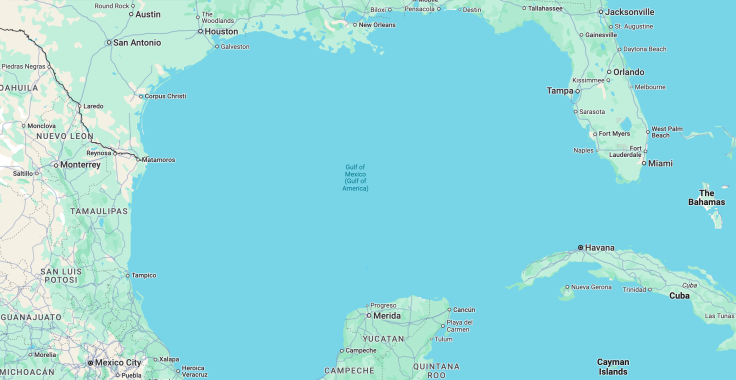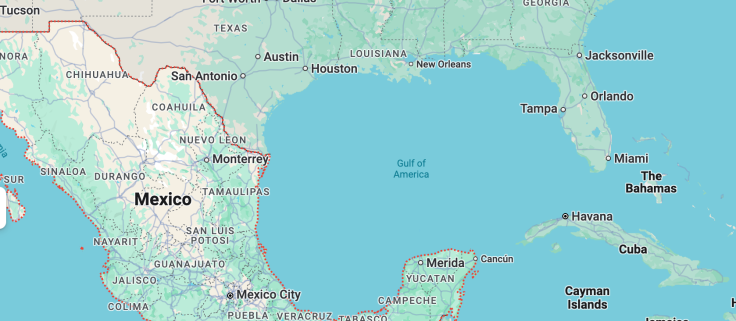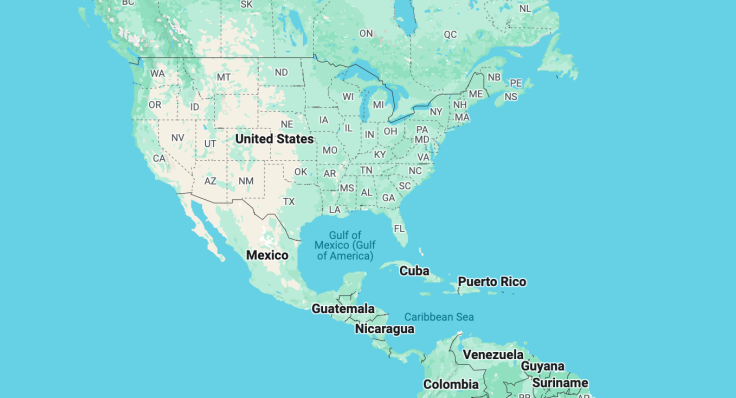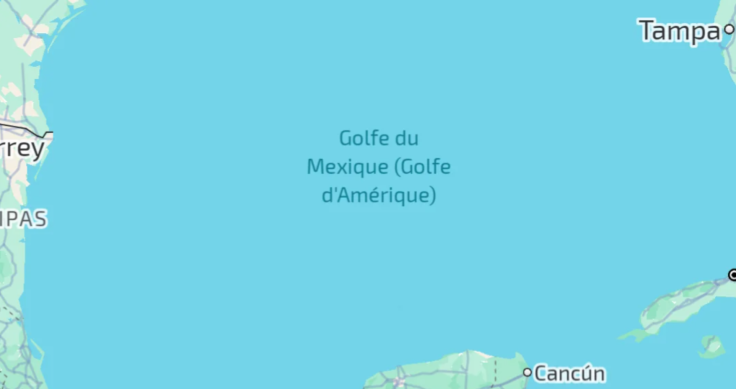Search For 'How To Report An Error On Google Maps' Spikes After Trump Renames Gulf Of Mexico
Trump celebrated the name change by posting a picture of the Gulf on Truth Social with the caption 'GULF OF AMERICA!'

Google Maps has become a hotbed of controversy after the platform reflected Donald Trump's decision to rename the Gulf of Mexico as the 'Gulf of America'—but baffled users have reported inconsistencies in how the name appears, sparking a wave of complaints.
Investigation Reveals Naming Inconsistencies
To verify these inconsistencies, I conducted a VPN test, changing my location between London, Mexico City, and Washington D.C. The results showed that the name shown on the maps can change based on factors like the user's location and the level of zoom used.
As of 11 February, it seems that the name is 'Gulf of Mexico (Gulf of America)' in Mexico and the U.S.

Additionally, if one searches 'U.S. map' or any variation of the same command, the name changes to 'Gulf of America.' If one searches 'Mexico map', the result is the same.

However, if one zooms out of the U.S./Mexico map, the name changes back to 'Gulf of Mexico (Gulf of America).' Even if one searches for a map of Cuba, which also borders the gulf, the name remains 'Gulf of Mexico (Gulf of America).'

This suggests that the changes have been implemented for users in Mexico and the U.S., but Google Maps is making an effort to avoid confusing users from other countries.
Google Maps's Name Change Sparks Confusion Worldwide
Bryan Metzger, a reporter for Business Insider, has posted proof of the name changing depending on how zoomed-in a user is.
Google Maps alternates between Gulf of Mexico/America depending on how far you’re zoomed in pic.twitter.com/UC6LVMI2pC
— bryan metzger (@metzgov) February 10, 2025
Reddit users on the r/GoogleMaps subreddit have discussed similar glitches. Reports suggest that the name of the Gulf varies depending on how much one zooms in or out. For all users outside of Mexico and the U.S., however, the name remains consistent as 'Gulf of Mexico (Gulf of America)', never just 'Gulf of America.'

These inconsistencies reportedly arose on 9 February after Trump signed the order to rename the Gulf. Frustrated users are flooding Google with error reports, hoping mass backlash will push the platform to reverse the change.
Public Backlash & Social Media Reactions
Frustrated Americans have taken to social media to voice their anger over Google Maps' renaming of the Gulf of Mexico to the 'Gulf of America'. The controversial change follows an executive order by President Donald Trump, but it has not been well received by the public.
One X (formerly Twitter) user raged: 'Google has removed Black History and Pride Month. Updated Google Maps to Gulf of America. So, what's an alternative search engine and map? Screw Google.'
Another remarked: 'It's funny how they put "Gulf of America" in parentheses so that Americans would stop insisting on that. It's like giving candy to a kid who won't stop crying to make him stop.'
Many users are now sharing step-by-step instructions on how to report the new name as an error, hoping Google will be pressured into reversing the decision. While some MAGA supporters have praised the move, the general consensus is one of disapproval, with critics arguing that the government should be focusing on more pressing matters rather than renaming a body of water.
British Officials and Public Reject the Change
It's not just Americans criticising the decision—Brits have also pushed back. A source within the UK civil service told The Telegraph that Britain will continue to refer to the Gulf by its recognised name until 'Gulf of America' becomes the globally accepted term—something they believe is highly unlikely. UK officials maintain that no single country can unilaterally rename an international waterway, and therefore, the new designation will not appear on government documents or UK products.
Outraged Britons have taken to comment sections to express their disbelief.
'Who in their right mind would agree with Trump's renaming?' asked Roger from Bath. 'This is just another sign of his narcissistic personality.'
Ian from Birmingham added: 'Donald Trump can call it whatever he wants. He doesn't have the power to make it official.'
Many have compared Trump's actions to the UK unilaterally renaming the North Sea the 'British Sea' without consulting Norway, Denmark, or the Netherlands, or renaming the English Channel the 'British Channel' without France's approval. The backlash has been swift, with critics calling the change 'petty' and 'pointless'.
Mexico Condemns the Name Change, While Trump Celebrates
While the Trump administration has hailed the name change as a patriotic move, Mexican officials have reacted with disbelief and frustration.
Mexican President Claudia Sheinbaum dismissed the decision, stating: 'For us and for the whole world, it is still the Gulf of Mexico.'
When Trump first proposed the change earlier this year, Sheinbaum countered by presenting a 1607 world map that referred to North America as 'Mexican America' and labelled the body of water accordingly. She quipped: 'Why don't we call it Mexican America? It sounds pretty, no?'
Trump, meanwhile, has fully embraced the change, posting an image of the Gulf on Truth Social with the caption: 'GULF OF AMERICA!' The White House has also issued a proclamation declaring 9 February as the first official 'Gulf of America Day'.
According to the proclamation, '[t]he area formerly known as the Gulf of Mexico has long been an integral asset to our once burgeoning Nation and has remained an indelible part of America.' Trump's statement also reiterated his administration's commitment to restoring 'American pride in the history of American greatness'.
Can Trump Legally Rename an International Waterway?
Despite Trump's enthusiasm, experts argue that the name change directly conflicts with international law.
Before the order was issued, Sheinbaum sent a letter to Google urging the company to reject the change, citing the United Nations Convention on the Law of the Sea. This treaty states that a nation's territorial waters extend only 12 nautical miles from its coastline, meaning the rest of the Gulf is under joint governance by the US, Mexico, and Cuba.
Sheinbaum reiterated this position last week, stating: 'If a country wants to change the designation of something in the sea, it would only apply up to 12 nautical miles. It cannot apply to the rest, in this case, the Gulf of Mexico.'
Cuba has yet to issue an official response, leaving many wondering whether Havana will align with Mexico's stance or remain neutral on the issue.
Google Attempts to Defend Its Decision
Google has faced significant backlash over the change, with critics accusing the company of pandering to Trump's administration. However, the tech giant insists it is following protocol.
In a statement addressing the controversy, Google explained: 'In the US, the Geographic Names Information System has officially updated "Gulf of Mexico" to "Gulf of America". As we announced two weeks ago and consistent with our longstanding practices, we've begun rolling out changes to reflect this update. People using Maps in the US will see "Gulf of America", and people in Mexico will see "Gulf of Mexico". Everyone else will see both names.'
Despite Google's claim of neutrality, users have reported that searches for Mexico's map still display 'Gulf of America', contradicting the company's statement. As public outcry and potential legal battles mount, it remains unclear whether Google will uphold the change or quietly reverse it.
Until then, searches for 'how to report an error on Google Maps' have skyrocketed, reflecting growing global frustration over what many see as political interference in geography.
© Copyright IBTimes 2025. All rights reserved.






















